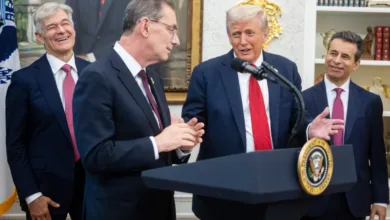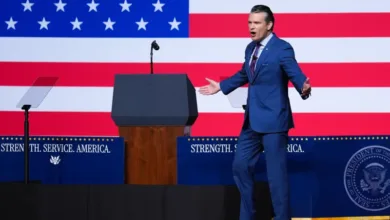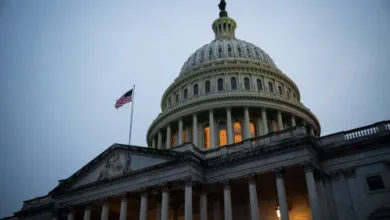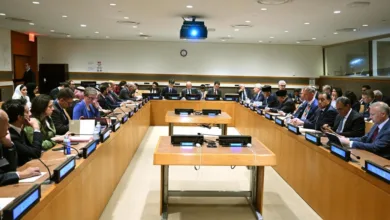Trump’s Ultimatum to Putin: Will the Ukraine War End by August 8

nsight: America’s Biggest Foreign Policy Gamble Yet As war continues to scar Ukraine’s landscape, Trump has thrown down a high‑stakes challenge to Putin: either commit to a withdrawal deal by August 8, or face severe consequences including U.S. submarine deployment and sweeping sanctions.
This dramatic move—widely regarded as a geopolitical turning point—throws American influence into sharp focus at a moment when global diplomacy hangs by a thread.
1. The Ultimatum Unveiled
In a media speech, Trump demanded that Russian troops initiate withdrawal negotiations or immediately face:
-
Bilateral sanctions targeting Russia’s energy exports and major banks
-
Deployment of U.S. submarines into Eastern European waters
-
A halt to all new diplomatic talks until withdrawal is under way
This message echoes a return to “tough talk” foreign policy. Behind the scenes, U.S. officials in Washington state this is the administration’s final diplomatic gesture before escalation.
2. Moscow Strikes Back
Kremlin sources quickly dismissed the warning as political posturing. Still, analysts note increased readiness among Russian naval command in the Black Sea. Anti‑access strategies reportedly being deployed raise fears of possible naval standoffs near Turkish waters.
Meanwhile, Russia has scaled back participation in arms treaties and is reportedly reviewing its posture on nuclear deterrence—prompting concern inside whitehouse channels about containment failure.
3. Diplomatic Push: Envoy Heads to Moscow
A U.S. envoy, whose identity remains unconfirmed, is scheduled to arrive in Moscow before the deadline—described by officials as America’s final bid to broker a peaceful resolution.
The temporary mission includes back‑channel discussions with Russian foreign ministry officials and military strategists. Analysts say this walk‑a‑tightrope approach may either defuse tensions or harden mutual suspicion.
4. European Reactions: Allies Caught Off‑Guard
In Brussels, EU leaders expressed alarm at the aggressive posture. NATO official commentary warns that abrupt shifts could unravel current peace efforts. Press statements emphasize concern over falling back into Cold War dynamics.
Germany’s coalition government called for urgent consultations; France issued a cautious rebuke, stating public opinion favors restraint over escalation—even if political pressure rises in U.S. primaries.
5. Military Consequences: Risk of Miscalculation
U.S. defense planners are reportedly reviewing ship routing options in the Northern Atlantic, Eastern Mediterranean, and Black Sea. Deploying war subs into these areas represents a risky escalation that could provoke naval confrontations.
Military experts warn that even unintended sonar ping incidents or miscommunication over restricted zones could rapidly spiral into broader conflict.
6. Forecasting Scenarios Post-August 8
De-escalation Path
If Russia begins dialogue, limited troop pullback may occur with observer oversight, allowing NATO to resume joint exercises in Poland and the Baltics.
Escalatory Path
But escalation remains possible: stronger cyberattacks on critical infrastructure, increased drone strikes, or intensified sanctions could spur Russia to retaliate or withdraw from international norms.
7. U.S. Domestic Political Aftershocks
Domestically, Trump‘s supporters laud the ultimatum as a demonstration of renewed American dominance. Critics rebuke the strategy as brinkmanship timed for electoral gain.
Broadcasters—especially FoxNews and TrumpNews affiliates—have divided coverage: some highlight a needed shift from diplomacy toward strength; others warn it risks international isolation and military entanglement.
In congressional circles, debates have erupted over whether this speech marks presidential aspiration power-play, or real national security strategy.
8. Historical Context: Echoes of Past Crises
Spectators recall parallels with the Cuban Missile Crisis and Cold War naval standoffs. Political historians compare the August deadline to Nixon’s moves toward the opening to China or Reagan’s early nuclear posturing.
This moment marks perhaps the highest-stakes gamble since the 1962 naval blockade—only modernized by smart submarines, AI surveillance, and precision missile technology.
9. Civil Society and Public Perception
Polling shows deep division: 42% of Americans support the ultimatum as necessary strength; 38% oppose it out of fear of war. Critics argue the strategy risks widening East–West divides at a time when U.S. credibility is already under question.
Meanwhile, think tanks and influential voices in thefive and GregGutfeld commentaries emphasize a perceived need to restore global deterrence—or face rising assertiveness from adversaries.
10. Economic Ramifications
Markets have begun to reflect heightened risk perception. Energy prices spiked on news of potential sanctions on Russian crude, while European equities declined modestly.
The Whitehouse and FederalReserve, guided by JeromePowell, are monitoring the fallout as uncertainty threatens inflation proxies and global supply chains.
11. What Might Come Next?
-
A continuation of NATO augmentation in Eastern Europe
-
Cyber escalation by Russia targeting Western infrastructure
-
A new U.S. proposal for multilateral peacekeeping measures
-
Escalation into proxy conflict in sensitive regions like the Baltic or Black Sea
Summary
Trump’s ultimatum delivers a clear message: diplomacy has a deadline. With August 8 looming, the Ukraine conflict’s next chapter may well be defined by risk, resistance, or reluctant resolution. This is not merely policy—it is a moment of reckoning.




